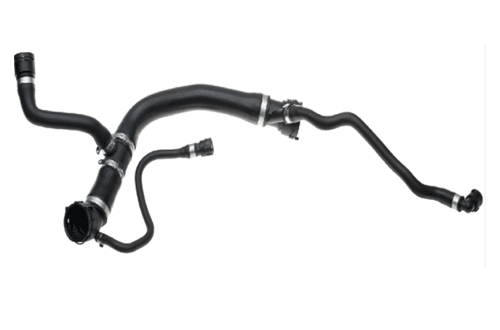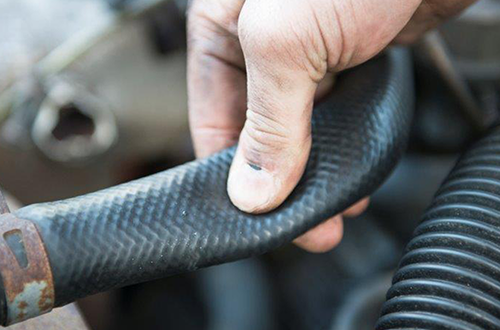Today’s car and trucks are more complicated than ever and continue to evolve. All vehicles have a cooling system and these systems no longer just keep the engine/motors cool; they cool and warm various components under the hood, as well as other areas of the vehicle. In order to convey coolant to these components the “radiator hoses”, as they were once called, have become much more complicated and even contain assorted elements built into the hose to perform a wide variety of tasks. These hose assemblies are called ‘modular’ coolant hoses, because they employ a variety of modules in their construction. A modular hose is defined as a coolant hose assembly, with one or more modules (which are built into the hose) and has coolant flowing through the modules(s). These modules can be a branching tee in the hose, quick-connect, valve, drain, air-bleeder or sensors.
As previously mentioned, modular hoses convey coolant to a variety of components on the vehicle; which in today’s world can include the fuel system, forced-air induction systems (turbo/superchargers), auxiliary heaters, inverters and battery packs, just to mention a few. There can also be multiple modular hoses on a vehicle, consisting of radiator hoses and heater hoses. You will primarily see this on European and domestic vehicles, but the Asian makes are quickly following suit.

These modules within the hoses are critical to the proper operation of the cooling system. For example, some hoses include flow-restrictors within the hose. These restrictors reduce the flow and pressure within the hose to certain components such as the heater core; and are required to maintain core integrity. The modules in these hoses are essential and include sensors which measure flow rate, temperature, etc., communicating directly with the ECM.
Technology comes with a cost. Modular hoses can be significantly more costly than standard, moulded coolant hoses. In general, a modular hose is likely to be three times the cost of a standard hose. Often, such hoses include multiple branches and connectors, with smaller I.D. heater-type hoses which snake around inside the engine compartment.
That brings us to hose failure. Coolant hose failures can lead to anything from a stranded-on-the-roadside driver, to a significant and costly engine overhaul. The premium EPDM rubber used in today’s coolant hoses will typically last over 150,000 kilometres. It is recommended an EPDM hose should be inspected at 100,000 kilometres and replaced at 150,000 kilometres to reduce the chance of failure, breakdown and costly engine repairs. Determining a worn-out hose just isn’t as simple as it used to be. Typical rubber hoses generally wear from the inside out. What was once a simple inspection and “squeeze test” to check for a failing hose is now a challenging assessment, even with the hose removed from the vehicle.

The most common failure mode on a standard, moulded hose is electrochemical degradation, or ECD. ECD is caused by an electrical charge being carried through the coolant from component to component. It occurs because the hose, liquid coolant and the engine/radiator fittings form a galvanic cell or “battery”. This chemical reaction causes micro-cracks in the hose tube, allowing the coolant to attack and weaken the hose reinforcement. Failures result from internal striations or cracks in the hose rubber, leading to pinhole leaks or a burst hose.
Oil and other petroleum-based products are another common cause of hose failure. Even EPDM rubber cannot withstand petroleum products for long, because it attacks the rubber compound and softens the hose. This can occur either externally; or internally by means of contaminated coolant. An oil-contaminated hose will feel spongy and bulges or swelling will be present. External oil leakage onto hoses should be corrected immediately and the hoses should be replaced. If a petroleum product contaminant is found within the cooling system; i.e. failed head gasket, it too should be repaired, and all coolant hoses replaced.
Heat and abrasion are other, regular failure causes found with these hoses. Always observe where the hoses are routed and protect the hose from heat sources, sharp objects, and even original metal cradles that came with the vehicle from the manufacturer. While standard, moulded hoses typically fail around 150,000 kilometres, modular hoses typically fail much earlier. The plastic utilised with the branching tees, quick-connects and other components are affected by the same conditions as the hose, particularly from heat and will become brittle over time.
Finally, treat the cooling system as a system because it is. When one component within the system fails, other components are soon to follow. All the components are manufactured with a similar life expectancy. If one hose fails, the others are soon to follow unless it’s a unique circumstance, so replacement of all hoses is always suggested. Additionally, other components such as the water pump, thermostat, radiator/reservoir cap, etc. are all part of the system and should be inspected at the same time. Finally, when replacing these components, it is imperative to flush the cooling system prior to component replacement. Flushing the system removes harmful contaminants, which is the only way to verify a clean system and to keep the vehicle running optimally.
It’s now more important than ever to maintain a vehicle’s coolant system. Not only is it necessary, but it’s profitable. Having the right parts, and in-stock is more important than ever, particularly when it comes to modular coolant hoses, which do tend to fail even earlier. Keep in mind that even as complicated as these hoses are, they do not need to be sourced from the OE dealer. All the major automotive retailers have access to these same quality parts in the aftermarket, at much better costs. Workshops should always be aware of the vehicles in their area, their fleet customers and repeat customers. Knowing what vehicles are in your area and the parts associated with those vehicles is easily accomplished using today’s parts manufacturers’ database of registered vehicles. Having the right part at the right time is critical to the success of your business.